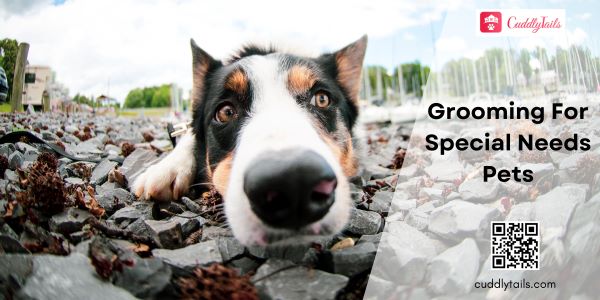Grooming for Special Needs Pets: Tips for Sensory-Impaired or Mobility-Challenged Animals
Grooming is an essential aspect of pet care that not only maintains their physical appearance but also contributes to their overall health and well-being. However, for pets with special needs, such as sensory impairments or mobility challenges grooming can present unique challenges. These furry companions require extra care and consideration to ensure their comfort and safety during grooming sessions. In this blog post, we’ll explore practical tips and strategies to make grooming a positive experience for both you and your special needs pet.
Understanding Your Pet’s Needs
Before embarking on a grooming routine, it’s crucial to understand your pet’s specific needs and limitations. Observing their behavior and consulting with a veterinarian or an expert to gain insights into their sensory or mobility challenges will help in tailoring the grooming approach to create a safe and stress-free environment for your special little friend.
Our 24/7 online vets can provide you with personalized solutions and insights on your pet’s needs. Read more about it here.
Gradual Desensitization
For pets with sensory impairments or mobility challenges, sudden changes or unfamiliar experiences can be overwhelming. To help them feel comfortable during grooming sessions, consider a gradual desensitization process.
Start by introducing grooming tools and sounds slowly and steadily, allowing your pet to become accustomed to them at their own pace. Reward calm behavior with treats and positive reinforcement to create positive reactions with the grooming process.
Accommodating Sensory Needs
Pets with sensory impairments, such as vision or hearing loss, may require specific accommodations during grooming. For animals with visual impairments, using verbal cues and gentle touch can help in guiding them through the grooming process. Maintaining a consistent routine and environment to minimize disorientation. For pets with hearing difficulties, consider using visual cues or vibrations to communicate with them and ensure their safety during grooming.
Mobility Aids and Positioning
Grooming can also be challenging for pets with mobility issues, such as arthritis, paralysis, or limb deformities. Investing in specialized grooming tables or non-slip mats can provide a stable surface for your pet, minimizing the risks of falls or discomfort. Additionally, explore creative positioning techniques, such as using ramps or lifting aids, to make the grooming process more comfortable and secure for your mobility-challenged pet.
Patience and Positive Reinforcement
Grooming special needs pets may require extra time and patience. Avoid rushing or forcing the process, as this can increase stress and anxiety for both you and your pet. Instead, breaking grooming sessions into smaller, manageable segments, and reward your pet’s cooperation with treats, praise, and affection. Positive reinforcement not only builds trust but also helps in creating a positive association with grooming.
Professional Assistance
In some cases, seeking professional assistance from a qualified groomer who specializes in caring for special needs pets may be beneficial. These groomers have the necessary knowledge, equipment, and techniques to address the unique needs of your pet while ensuring their safety and comfort. Additionally, they can provide valuable advice and guidance on ongoing grooming routines and products tailored to your pet’s specific requirements.
Grooming Tools and Products
Selecting the right grooming tools and products can make a significant difference in the grooming experience for special needs pets. Look for tools with soft bristles, rounded edges, and non-slip grips to minimize discomfort and ensure a secure grip. Additionally, consider using pet-friendly grooming products specifically formulated for sensitive skin or coat types, as these can help alleviate any potential irritation or discomfort.
Monitoring for Signs of Stress
During grooming sessions, it’s essential to monitor your little one closely for signs of stress or discomfort. These may include panting, trembling, excessive vocalization, or attempts to escape. If you notice any of these signs, take a break and rearrange the situation. Forcing on the grooming process when your pet is distressed can lead to negative associations and further induce anxiety during grooming sessions.
Consistency and Routine
Establishing a consistent grooming routine can be particularly beneficial for special needs pets. Animals thrive on predictability, and having a regular grooming schedule can help them feel more comfortable and secure. Sticking to a consistent time, location, and approach, and involving the same trusted individuals in the grooming process can help in minimizing any potential stress or confusion.
Celebrate Small Victories
Grooming special needs pets can be a challenging journey, but it’s essential to celebrate small victories along the way. Whether it’s your pet trying to be comfortable with a few extra brushstrokes or allowing you to trim a couple of nails, recognize and reward these accomplishments. This positive reinforcement will not only strengthen your bond with your pet but also encourage continued progress during future grooming sessions.
Conclusion
Grooming is an integral part of pet care, but for special needs pets, it requires extra attention, patience, and specialized approaches. By understanding your pet’s unique needs, creating a safe and comfortable environment, and incorporating positive reinforcement techniques, you can turn grooming sessions into a bonding experience that benefits both you and your furry companion. Remember, every pet is unique, and embracing their individuality with love and care is the key to a successful grooming routine.
If you have a senior pet, reading about techniques for grooming them will make it easier for everyone.

